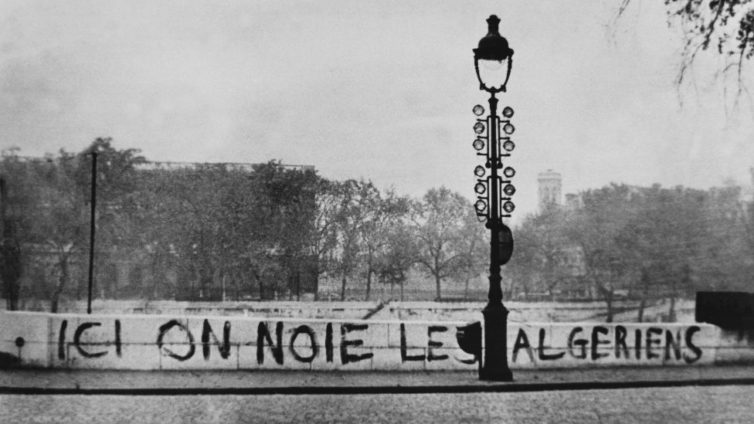"It was a miracle I was not thrown into the Seine," Algerian Hocine Hakem recalled about an infamous but little-known massacre in the French capital 60 years ago.
Around 30,000 Algerians had taken to the streets of Paris in a peaceful protest against a curfew, and calling for independence nearly seven years into the war against French rule in North Africa.
The police killed hundreds of protesters and dozens of others were thrown into the River Seine, making it one of the darkest pages of France's chequered colonial history.
Mr Hakem was 18 at the time and was telling his story to the L'Humanité newspaper decades after the event, which was little reported at the time. He was among about 14,000 Algerians arrested during the operation.
The government of the day censored the news, destroyed many of the archives and prevented journalists from investigating the story. Contemporary news bulletins reported three deaths, which included a French national. It was not covered in the international press.
Brigitte Laîné, who was a curator at the Parisian archives, said in 1999 that some official documents survived revealing the extent of the killings. "There were a lot of bodies. Some with the skulls crushed, others with shotguns wounds," she said.
One photo captured the chilling sentiments of the time, showing graffiti scrawled along a section of the Seine's embankment saying: "Here we drown Algerians."
This is the title of French historian Fabrice Riceputi's new book which details how one man - researcher Jean-Luc Einaudi - tirelessly sought to gather eyewitness testimony, publishing his account 30 years after the police massacre.
It is now believed that between 200 and 300 Algerians were killed that day.
A total of 110 bodies washed up on the banks of the River Seine over the following days and weeks. Some were killed then dumped, while others were injured, thrown into the cold waters, and left to drown.
The youngest victim was Fatima Beda. She was 15 and her body was found on 31 October in a canal near the Seine.
Anti-Arab racism
One of the earliest descriptions of the event was published in 1963 by African-American writer William Gardner Smith in his novel Stone Face - though it is a fictionalised account, which has never been translated into French.
It shows the stark anti-Arab racism of the day.
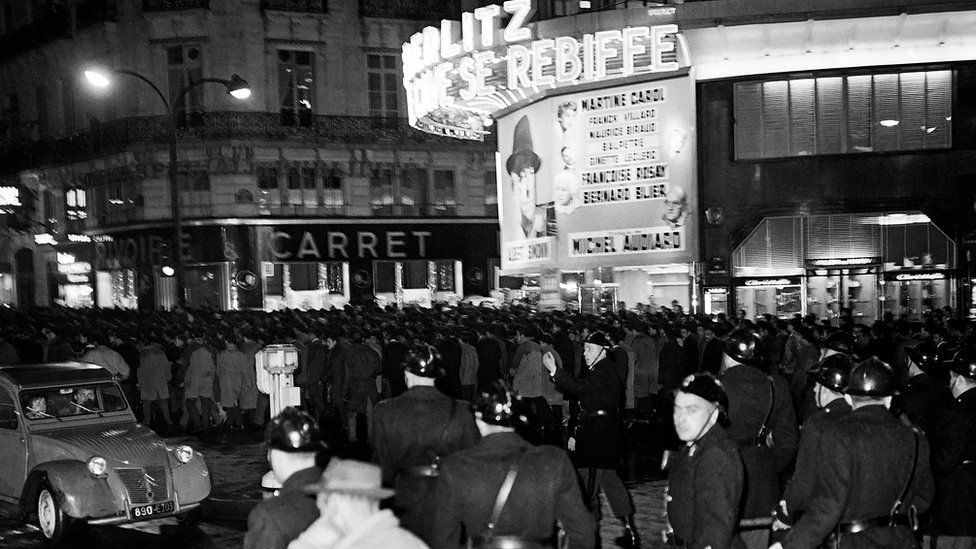
Mr Riceputi believes the French state is still refusing to face up to this racist heritage.
As the 60th anniversary of the killing approached, the often testy relations between France and Algeria - which had been undergoing a slow rapprochement - have once more hit the buffers.
The spat began last month when France slashed the number of visas granted to Algerians, accusing its former colony of failing to take back those denied visas.
But it was an audience President Emmanuel Macron held with young descendants of those who had fought in the Algerian War that has prompted the most anger.
He questioned whether the Algerian nation would exist if it hadn't been for French colonisers.
It may have been meant in the spirit of debate but it has provoked a backlash from Algerians who see it as symptomatic of France's insensitivity and the cover-up of colonial crimes.
No apology
When it comes to the Paris massacre, the state has done very little.
In 2012 François Hollande recognised that it had happened - the first time a French president had done so.
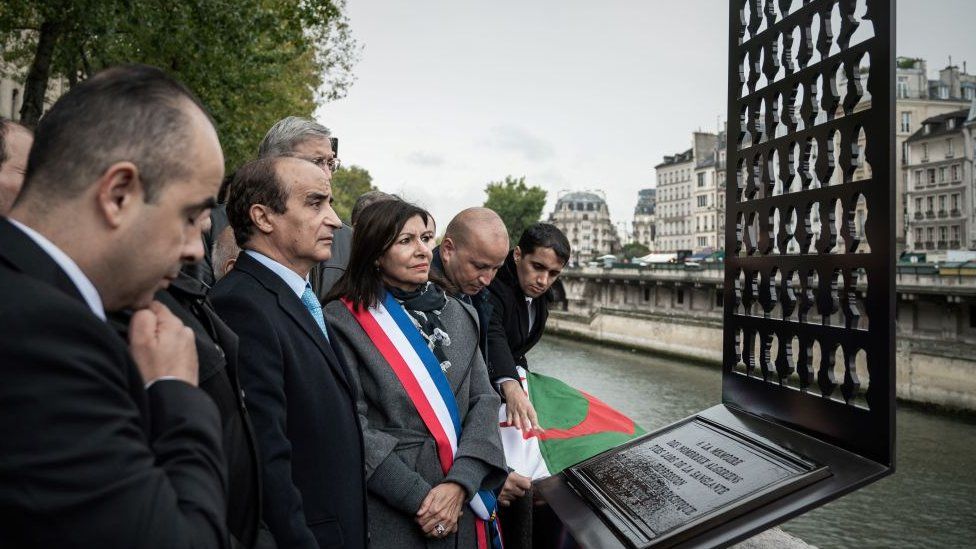
In a statement to mark the 60th anniversary of the massacre, President Macron said that crimes committed under the authority of the police chief were "inexcusable".
Yet both have fallen short of the expectations of those who have been calling for an apology and reparations - and neither acknowledged how many people died or the state's role.
French left-wing parties, who were in opposition at the time, have also come in for criticism for not condemning the massacre. They have been seen as complicit in the cover-up given that they filed a law suit against the police for opening fire on mainly French anti-war protesters, killing seven, a few months later, and yet remained silent about the massacre of Algerians.
Mr Riceputi says the racist nature of the operation cannot be ignored - every person who looked Algerian was targeted.
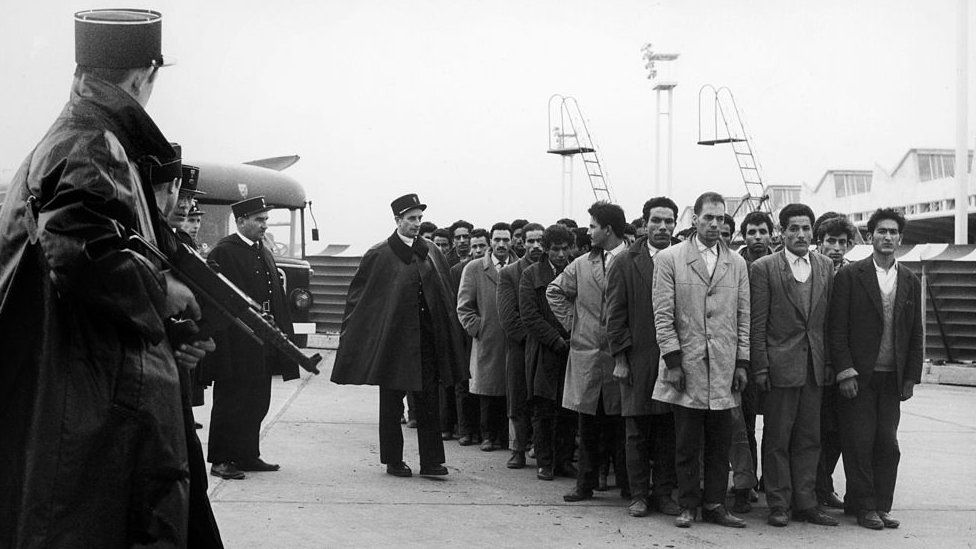
The campaign waged against Algerians in Paris was unofficially called the "ratonnade", meaning "rat-hunting".
The search for Algerians continued for days after 17 October, with the police making arrests on public transport and during house searches.
It was reported that Moroccans had to put up the sign "Moroccan" on their doors to avoid being harassed by repeated police raids.
Portuguese, Spanish and Italian immigrant workers with curly hair and dark complexions complained about systematic stop and searches as they were mistaken for Algerians by the police.
Researchers also say that it was not only the police and security forces who took part in the operation - firefighters and vigilantes were also involved.
Thousands were illegally deported to Algeria where they were detained in internment camps despite being French citizens.
Fearsome reputation
At the time President Charles de Gaulle was in advanced negotiations with Algeria's National Liberation Front (FLN) to end the war and agree to independence. The war ended five months later and independence followed in July 1962.
But in 1961, tensions were running high and on 5 October the Parisian authorities banned all Algerians from leaving their homes between 20:00 and 05:30.
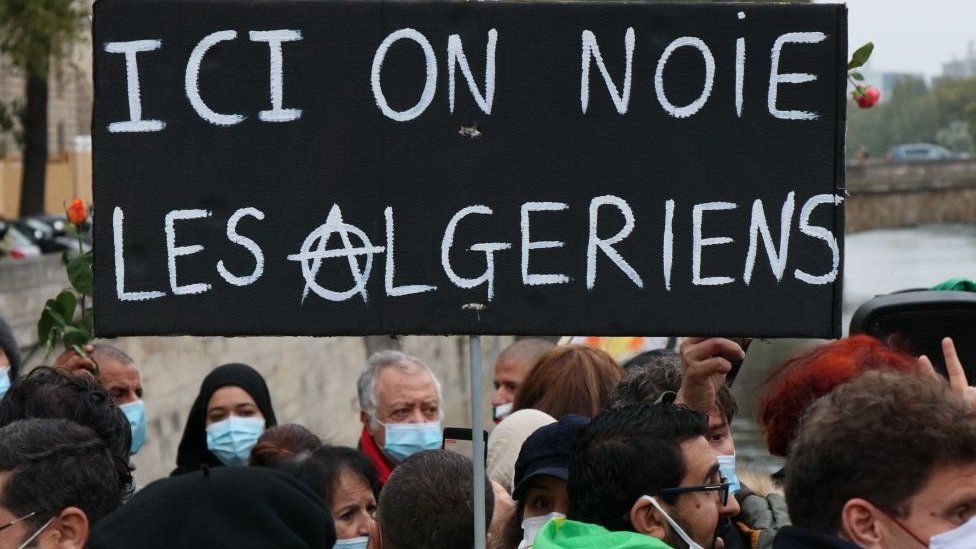
The march was called in protest at the curfew. The organisers wanted to ensure it was peaceful and people were frisked before boarding trains and buses from the run-down suburbs to go into central Paris.
It has not yet been established what exact instructions were given to the security forces, but the Paris police chief at the time, Maurice Papon, had a notorious reputation.
He had served in Constantine in eastern Algeria where he supervised the repression and torture of Algerian political prisoners in 1956.
He was later convicted in French courts of overseeing the deportation of 1,600 Jews to Nazi concentration camps in Germany during World War Two when he was a senior security official under the Vichy government.
It was this prosecution - that took place between 1997 and 1998 - that lifted the lid on some of the classified archives relating to the 17 October massacre, and paved the way for extensive research into the extraordinary cover-up.
Preliminary official inquiries into the events were made - and a total of 60 claims were dismissed.
No-one was tried as the massacre was subject to the general amnesty granted for crimes committed during the Algerian War.
For Mr Riceputi the hope is that this 60th anniversary will help with efforts to establish the truth and determine the responsibility for one of the bloodiest police massacres in France's history.
Latest Stories
-
Paris 2024: Opening ceremony showcases grandiose celebration of French culture and diversity
3 hours -
How decline of Indian vultures led to 500,000 human deaths
4 hours -
Paris 2024: Ghana rocks ‘fabulous fugu’ at olympics opening ceremony
4 hours -
Trust Hospital faces financial strain with rising debt levels – Auditor-General’s report
4 hours -
Electrochem lease: Allocate portions of land to Songor people – Resident demand
5 hours -
82 widows receive financial aid from Chayil Foundation
5 hours -
The silent struggles: Female journalists grapple with Ghana’s high cost of living
5 hours -
BoG yet to make any payment to Service Ghana Auto Group
5 hours -
‘Crushed Young’: The Multimedia Group, JL Properties surprise accident victim’s family with fully-furnished apartment
6 hours -
Asante Kotoko needs structure that would outlive any administration – Opoku Nti
6 hours -
JoyNews exposé on Customs officials demanding bribes airs on July 29
7 hours -
JoyNews Impact Maker Awardee ships first consignment of honey from Kwahu Afram Plains
8 hours -
Joint committee under fire over report on salt mining lease granted Electrochem
8 hours -
Life Lounge with Edem Knight-Tay: Don’t be beaten the third time
8 hours -
Pro-NPP group launched to help ‘Break the 8’
8 hours

